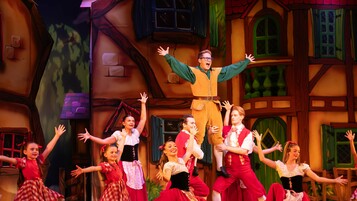News Story
Colourful sets, outlandish costumes, slapstick comedy, gender reversal, and audience participation are all reasons why we love pantomime. It's ingrained in British theatre, but do you know how pantomime started and where it came from? Some people consider panto to be a relatively recent creation. However,pantomime has evolved over several hundred years to become the impressive spectacle we know and love today. Come with us as we explore pantomime's vibrant and eclectic history!
Panto’s Beginnings: Commedia dell’Arte:
Pantomime developed from 16th century Commedia dell'Arte, a street theatre genre from Renaissance Italy. Performances featured slapstickcomedy and familiar panto characters. Small companies would tour France and Italy, performing at fairgrounds and in marketplaces, telling stories of the clown ‘Pierrot’, old man ‘Pantalone’ and ‘Columbine’, a girl who fell in love with a wayward servant called ‘Arlecchino’. In some versions, ‘Pantalone’ (or Pantaloon) had a servant called ‘Punchinello’, a clownish character who can still be seen today as Mr. Punch.
Performers wore distinctive masks so audiences could recognise certain characters; this way actors could make risqué and often topical jokes without being recognised. Actors eventually took their performances across Europe where they visited England. Working with playwrights such asShakespeare, Lope de Vega, and Moliere who took inspiration from these Commedia traditions and characters.
Did you know, the rebellious energy and iconic masks of Commedia's performances have influenced the work of composers and artists such as David Hockney and Picasso.
Panto arrives in England:
Introduced to the theatre in the late 1600s by John Rich, a leading theatre impresario (today’s theatre managers or promoters), Commedia dell'Arte characters regularly featured in English comedy plays.
Rich's plays, known as harlequinades, saw the acrobatic Harlequin character take centre stage. The stories involved magic and acrobatics, comedy chases and love interests - everything you'd expect from a pantomime. Harlequin would use his ‘slapstick’ (often a bat or sword) to hit scenery and instigate set changes. Actor and comedian Joseph Grimaldi, regarded as the most popular English entertainer of the Regency era, expanded the role of the clown in harlequinade, that formed part of the traditional British panto, at a number of notable theatres including Covent Garden Theatre and Theatre Royal Drury Lane.
By Victorian times, pantomime had become a key Christmas event and included fairytales or stories of Robinson Crusoe told with a witty rhyming style and topical content.
Enter the Dame:
The pantomime dame character, which we know today, first emerged from the Victorian music halls generally taking the role of the hero's mother - think Dame Trott in Jack and the Beanstalk and Widow Twankey in Aladdin. Audiences relished watching well-known male comedians performing on stage in outrageous costumes and make-up. As we see today, thedame character was typically portrayed as unattractive, older and common, despite the character thinking of herself as the opposite. She would usually befriend the two principal characters and be instrumental in all the good acts performed in the story. Meanwhile, the principal boy was typically played by a woman, giving the Victorian gentleman in the audience a rare glimpse of a lady’s ankle!
Father of modern pantomime:
Augustus Harris was a dominant figure in West End theatre and often referred to as the ‘father of modern pantomime’. He encouraged lavish productions and competition between British theatres. When he took over the lease of London's Theatre Royal, Drury Lane, he staged spectacular annual pantomimes that ran from Easter to Christmas.
The future of panto:
Pantomime's ability to adapt and move with the times has helped it survive for hundreds of years. Successfully weaving modern trends and topicality into its established format, panto continues to be one of Britain's most popular and endearing forms of entertainment. While the Commedia dell'arte it derived from has almost disappeared, panto, as we know it today, is a wonderful and entertaining art form, which continues to entertain and dazzle audiences!
If this has whetted your appetite for seeing a pantomime this year, why not book your tickets to watch Jack & the Beanstalk at the Bournemouth Pavilion Theatre, starring Calum Lill from Coronation Street as the villainous Fleshcreep, David Ribi from Channel 5’s Milkshake! as Jack and, back despite popular demand (!), Noel Brodie as Silly Simon. With Rachel Grundy as Princess Jill and Oliver Brooks as Dame Trott.
Jack and the Beanstalk, a UK Productions Ltd production, will run at Bournemouth Pavilion from Saturday 7 December 2024 – Sunday 5 January 2025. Tickets and more information are available here. School and group rates available, please email schools@bhlive.org.uk.
© Content provided by UK Productions Ltd.




